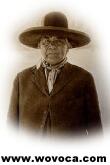The Traditional Version
In order to head off a war between Spain and Portugal over discoveries in
the New World, Pope Alexander VI divided the territory with an imaginary
"line of demarcation" in 1493. The land to the east of the line -- which
ran north to south several hundred miles west of the Azores and Cape Verdes
-- "belonged" (!) to Portugal, while that to the west was "given" (!) to
Spain. Almost 40 years after this papal decree, soldier of fortune Francisco
Pizarro set out for Peru to secure the pagan kingdom of the Incas for Charles
V of Spain and the Catholic Church.
Accompanied by 168 soldiers, Pizarro disembarked confidently. As the
conquistadores, wearing shining armor and mounted on horses, rode inland
from the sea toward the Inca city of Cajamarca, they were greeted along the
way by awestruck natives. In Cajamarca, Pizarro was to meet with Atahualpa,
the tyrannical Inca ruler. However, once inside the city, the Spaniards saw
that they were surrounded by thousands of Inca warriors, and the prepared
to fight the heathen for the glory of God and Spain. Despite their lesser
numbers, Pizarro’s men had superior arms and easily routed the primitive
Inca army. They took Atahualpa prisoner and later executed him because Pizarro
feared the possibility of reprisal. Without their leader, the Incas readily
accepted Christianity and Spanish rule.
The Other Side
In many ways Inca civilization was more advanced than that of Western Europe.
Inca physicians were performing successful brain surgery while their European
counterparts still prescribed leeches for just about every ailment. Inca
architecture, agriculture, and astronomy had progressed amazingly, too, but
perhaps the most remarkable Inca achievement concerned social order. In their
society there were no poor people. Widows, orphans, and invalids were cared
for by the state, and workers retired at age 50 on pensions of food and clothing.
There was little crime because every basic need was met. At the head of this
benevolent system was the ruler, or Inca, who demanded in exchange the obedience
of his subjects.
When Pizarro landed in Peru in 1532, all he knew of the Incas was that, according
to legend, they possessed fabulous wealth. His twin objectives were to loot
the empire and to subjugate its people to not only Christianity but also
to Spanish rule. The conquistadores had arrived at a most opportune time.
Both Atahualpa and his half-brother Huascar had claimed the throne after
their father, Huayna Capac, died in 1525 without formally naming his successor.
Although Capac’s priest designated Huascar the ruler, a civil war erupted
between the two brothers and lasted until 1532, when Atahualpa’s forces
captured and imprisoned Huascar. Huascar was forced to witness the slaughter
of the royal family; hundreds of women, men, and children were killed so
Atahualpa could reign without further challenge. Atahualpa’s bloody
power play disrupted the ordered Inca society, and the natives hailed Pizarro
as a son of their white-skinned God Viracocha, sent, they believed, to avenge
Huascar and his family. The Spaniard did not abuse them. The sound of his
cannon added credence to this false identity, since Viracocha controlled
the thunder. As the conquistadores plundered their way cross-country, they
met with no resistance from the thoroughly intimidated and demoralized Incas.
However, when word of the Spaniards’ conduct during their trek to Cajamarca
reached Atahualpa, he demanded that the thieves return the goods they had
stolen. Instead, they sent him a priest, Brother Vicente, who proceeded to
instruct Atahualpa in Western religion. The catechism lesson ended abruptly
when Atahualpa hurled a bible on the ground. At this, the offended Spaniards
-- who the night before had been whipped into a religious frenzy by Pizarro
-- attacked and slaughtered the unarmed natives. The Inca warriors stationed
outside the city scattered before the onslaught of the Spanish artillery.
Atahualpa was taken captive and held for ransom. When he learned that Huascar
was promising the Spanish more gold for his own release, the ruthless Atahualpa
secretly ordered his brother’s death. During the next nine months, a
roomful of gold and silver was delivered to Pizarro to secure Atahualpa’s
safe return to the throne, but the Spaniard had no intention of releasing
his prisoner. Pizarro knew that, in order to disrupt and conquer this well-run
society, he must kill the Inca leader. After a mock trial at which Atahualpa
was found guilty of trumped-up charges, Pizarro offered him a choice: He
could elect to be burned alive as a heathen or to be strangled as a Christian.
When the Inca ruler chose the latter, he was baptized Juan de Atahualpa in
honor of St. John the Baptist. Then he was tied to a stake a garroted. Pizarro
and his men gave the Inca a full-scale Catholic funeral.
Eyewitness Account
"Friar Vicente... came forward holding a crucifix in his right hand and a
breviary in his left and introduced himself as another envoy of the Spanish
ruler, who according to his account was a friend of God, and who often worshiped
before the cross and believed in the Gospel. Friar Vicente called upon the
Inca to renounce all other gods as being a mockery of the truth.
"Atahualpa’s reply was that he could not change his belief in the Sun,
who was immortal, and in the other Inca divinities. He asked Friar Vicente
what authority he had for his own belief, and the friar told him it was all
written in the book which he held. The Inca then said, ‘Give me the
book so that it can speak to me.’ The book was handed up to him, and
he began to eye it carefully and to listen to it page by page. At last he
asked, ‘Why doesn’t the book say anything to me?’ Still sitting
on his throne, he threw it on the ground with a haughty and petulant gesture.
"Friar Vicente found his voice and called out that the Indians were against
the Christian faith. Thereupon Pizarro and Almagro (his lieutenant) began
to shout orders to their men, telling them to attack these Indians who rejected
God and the Emperor. The Spaniards began to fire their muskets and charged
upon the Indians, killing them like ants. At the sound of the explosions
and the jingle of bells on the horses’ harness, the shock of arms and
the whole amazing novelty of their attackers’ appearance, the Indians
were terror-stricken. The pressure of their numbers caused the walls of the
square to crumble and fall. They were desperate to escape from being trampled
by the horses, and in their headlong flight a lot of them were crushed to
death. So many Indians were killed that it was impracticable to count them.
As for the Spaniards, only five of them lost their lives, and these few
casualties were not caused by the Indians, who had at no time dared to attack
the formidable strangers. The Spaniards’ corpses were found clasped
together with their Indian victims, and it was assumed that they had been
mistakenly trampled to death by their own cavalry."
From: "The People's Almanac #3" by David Wallechinsky and Irving
Wallace
Return to Hidden
and Suppressed History











![[Image]](pict41.jpg)
![[Image]](pict43.jpg)